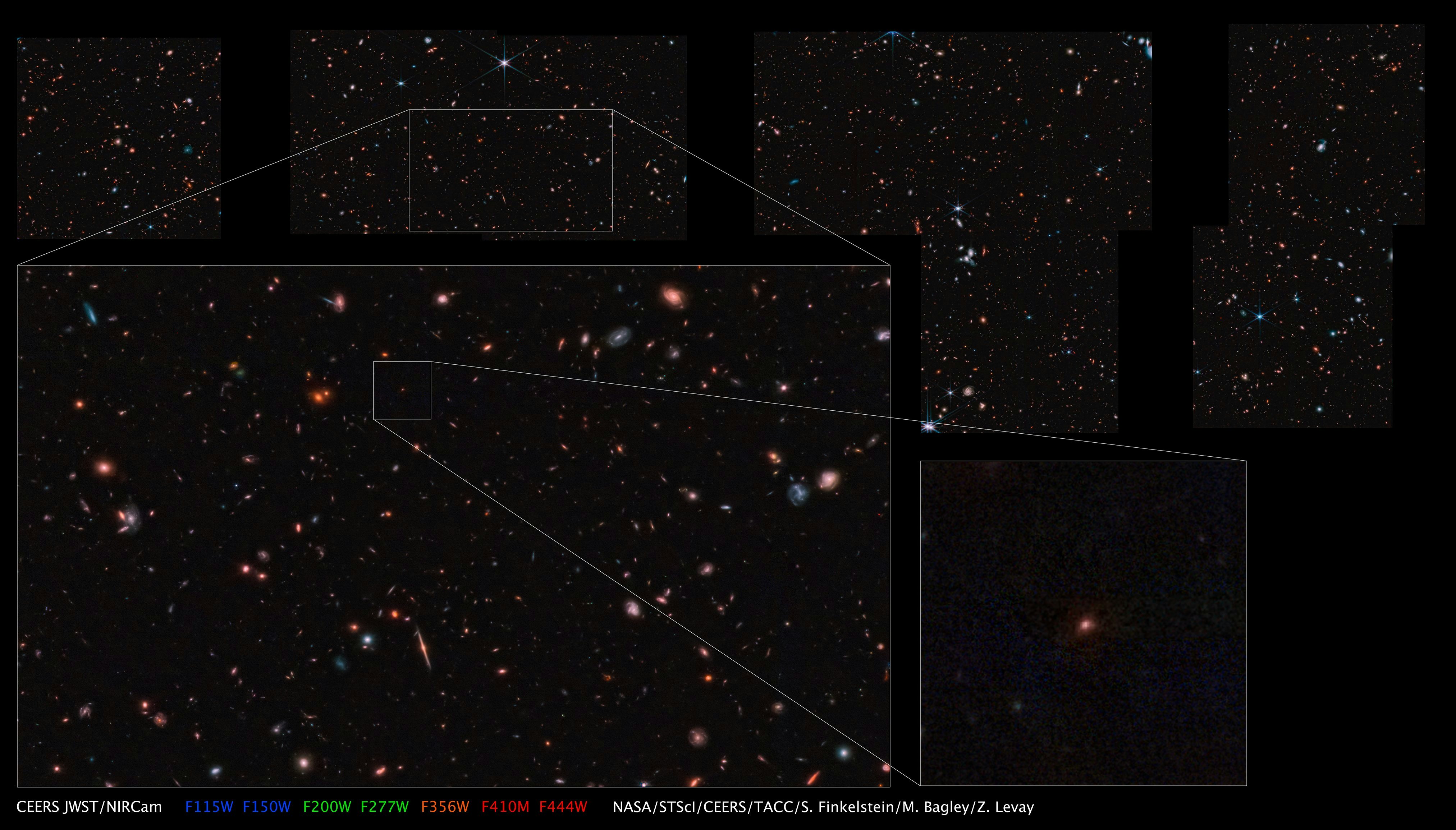
Thanks to an international team of astronomers, the largest image yet taken by the James Webb Space Telescope was released yesterday. CEERS, the Cosmic Evolution Early Release Science Study, has released a massive mosaic of all the data they were able to gather in their first observations of the early universe, with what they refer to as “an unexpected, but not unwelcome, abundance of never-before-seen galaxies.”
The large team is made up of nineteen investigators and a full team of 105 scientists across 28 institutions around the world, all working together to scout out the earliest galaxies ever detected. To do this, they have tasked the Webb Space Telescope’s instruments to search through a tiny sliver of the night sky in never-before-seen detail.
The image that has been released is actually made up of data from the Near Infrared Camera (NIRCam), the Near Infrared Spectrograph (NIRSpec), and the Mid-Infrared Instrument (MIRI) taken in parallel and carefully stitched together. Because JWST receives data in wavelengths that aren’t visible to humans, this lets the team look at some of the earliest galaxies and simultaneously investigate their emissions and the elements that make them up.

The official release zooms in on six especially interesting galaxies out of the vast number contained in the immense image.
The first is a beautiful bright blue spiral arm galaxy at a relatively recent redshift of 0.16. You can easily make out bright pockets of star formation within the arms of the galaxy.
The second is an elliptical galaxy at a redshift of 1.05 that team member Rebecca Larson, a University of Texas Austin astronomy doctoral student, dubbed Pac-Man. The much larger elliptical galaxy looms in front of an arc of smaller, evenly sized, evenly spaced galaxies. Of course, it’s nowhere near devouring the dots in front of it.
The third is a set of interacting galaxies from around 9 billion years ago that CEERS primary investigator Steven Finklestein nicknamed the Space Kraken.
The fourth is two spiral galaxies interacting. By comparing it with (less crisp) imagery of the same galaxies taken by the Hubble Space Telescope over the last decade, astronomers have likely found the Webb Space Telescope’s first supernova. This research, published last month in AstroNotes, is one of several investigations that have already begun to spin off from the images gathered by CEERS.
The fifth is an extremely detailed image of a spiral galaxy from 6.4 billion years ago. The sixth is a set of bright red and orange merging galaxies that CEERS used to compare the sharpness of the Webb Space Telescope’s imagery against Hubble during the first releases.
The data included in this image may also include the earliest galaxy that has ever been observed. “Maisie’s Galaxy” — the team named it after Finkelstein’s daughter — appears to be at a redshift of at least z=11.8, which would make it 13.3 billion years old, or from the first 400 million years after the Big Bang. And in a submission to the Astrophysical Journal posted to arXiv in July, the team suspects that this galaxy may be even older, from the first 300 million years of our universe’s existence.

If this galaxy is confirmed to be at as high of a redshift as the CEERS team expects, then it would indicate that massive galaxies were already forming in the earliest days of the epoch of reionization, when the plasma that evenly filled the early universe collapsed into more familiar stars and galaxies.
Despite its tremendous size and all the ancient galaxies contained within it, the image is just a tiny slice of the sky. It only covers about 1.5 arcminutes — about 1/20 the width of the moon — near the handle of the Big Dipper.
This is not the end of the survey, either. This image comes from a mosaic of the first 40% of the team’s planned observation schedule with the Webb Space Telescope. The work on the CEERS program won’t be completed until December, when the telescope will return to the right alignment.







